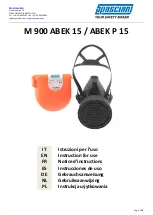
13
DEPOLOX® 5 E flow cell
3. Description
EN
3.5.2 Function
The sample water is connected on the input
side to the shut-off ball valve via the G1/2”
connection. The input pressure must be
around 0.25 to 3.0 bar. To guarantee a cons-
tant flow, the minimum input pressure must
not be less than 0.25 bar. Otherwise, an opti-
onal booster pump must be used. If the admis-
sion pressure exceeds 3.0 bar, an optional
pressure reducing valve must be used.
The sample water flows over the optional
strainer, which prevents dirt particles pene-
trating into the flow cell.
The sample water flows in the flow direction
to the check valve housing through the filter
unit or through the built-in fine filter (memb-
rane sensors only). In the filter unit a stainless
steel fine filter (sample water fine filter) with a
mesh size w=500 µm can be installed. The fine
filter is only used in conjunction with the
membrane sensors.
The check valve housing provides a kick-back
function and guides the ball for monitoring
the flow rate.
The multi-sensor monitors the correct flow by
the float principle with reed switch and mea-
sures the temperature with the Pt1000. The
large-surface transducer grounding is through
the stainless steel sensor housing.
The flow control valve ensures a flow of the
sample water that is not dependent on the
operating pressure. The correct sample water
flow of 33 l/h is factory-preset, checked and
logged. If the admission pressure rises, the
valve ball moves towards the closing direc-
tion; if the admission pressure drops, the ball
moves towards the opening direction.
In the cell body the 3-electrode measuring cell
(H) with external potentiostatic control circuit
and refillable electrolyte tank is fitted. Wor-
king and counter electrodes are designed as
half-ring electrodes and consist of a special
platinum alloy. The reference electrode is a sil-
ver–silver chloride electrode, which is connec-
ted to the sample water via two membranes.
The reference electrode immerses in an elec-
trolyte solution and can also be refilled during
operation.
The sample water that flows tangentially into
the 3-electrode measuring cell ensures conti-
nuous hydromechanical cleaning of the sensor
electrodes with special cleaning sand, thereby
preventing natural soiling of the electrode sur-
faces. Clean electrode surfaces and a constant
flow of sample water are decisive criteria for a
qualitative good oxidizing agent measure-
ment and quick response.
The 3-electrode measuring cell is connected
to 700 P electronics module or 700 M electro-
nics module through DFMe electronics
module (DES sensor module for 3-electrode
measuring cell). The adjustable cell voltage
Upot is output through the potentiostatic con-
trol circuit. A measuring cell current (µA sig-
nal) that is proportional to the disinfectant
concentration in the sample water is evalua-
ted with the 700 P electronics module or
700 M electronics module.
The cell body, which can be lit, holds the sen-
sors and is designed to allow convenient clea-
ning and servicing. These additional sensors
are installed in the mounting hole of the cell
body cover with standard thread connections
or in special sensor mounts.
The LED glow stick is fitted in the cell body
cover for visual inspection of the sensors, sand
cleaning and for color indication of messages
or faults.
The sample water runs off directly through the
top cell body outlet through an outlet nozzle
for hoses with inner diameter 6 mm. In the
case of the pressurized version, the sample
water runs off through a shut-off ball valve
with G 1/2” A-connection. With the pressuri-
zed version, a maximum back pressure of 1.5
bar is permitted here.
For calibration, a sample taking unit is fitted. It
is used to draw sample from the cell body
through the low-pressure side of the flow con-
trol valve and to drain the cell body for servi-
cing.
Two calibration holding clips are attached in
the cover of the DEPOLOX® 5 E flow cell. For
hands-free calibration of the sensors with buf-
fer solution and calibration solution (bag or
cup) the two calibration mounting brackets
are inserted on the side at the back of the
main housing.














































